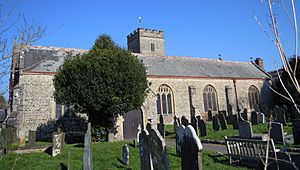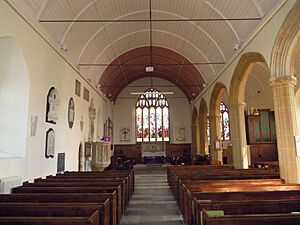Church of St Peter, Fremington facts for kids
The Church of St Peter is an old and important church in Fremington, a village near Barnstaple in England. It's an Anglican church, which means it belongs to the Church of England. People have worshipped here for a very long time, with records showing a church on this spot since at least 1268. Most of the church you see today was built in the 1200s and 1400s. It's also a special building, listed as Grade II* listed since 1965, meaning it's historically important.
Contents
History of St Peter's Church
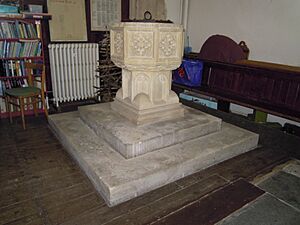
There has been a church on this site for many centuries. We know a chaplain, Roger, was appointed here in 1268. There are also signs that parts of the church were built by the Normans after they conquered England in 1066. The church is made from rough stone with smoother stone details.
The porch and the bell tower are the oldest parts of the church. They still have parts of Norman arches from the 1100s and 1200s. Near the church door, there's a special stone basin called a holy water font. People used to dip their fingers in it and make the sign of the cross before going inside. This basin is very old, from before the 1500s.
The square tower might have once had a pointy roof covered in lead. We don't know why it was removed. Between the 1200s and 1400s, the church was made bigger and more beautiful. It now has two main sections with two roofs, one smaller than the other. These sections have pillars and arches in a style called Perpendicular Gothic.
Changes Over Time
In 1813, some old pillars and a fancy wooden screen were taken out. They were replaced with simpler columns. A special area for singers and musicians was also added at the back of the church. The beautiful window frames were removed too.
However, things changed again in 1867. A famous architect named Sir Gilbert Scott was working on another church nearby. He was hired to help St Peter's in Fremington. Scott reversed many of the earlier changes. The singing area was removed, and eight new columns were put in. These columns were decorated with carvings of vines, fruit, and even some funny faces.
New stone window frames were put in, and some of the old, fancy window parts were found and put back. The church was ready for worship again in 1867.
Special Features Designed by Scott
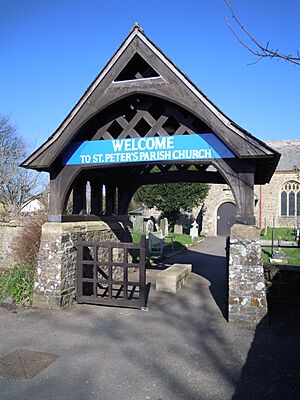
Sir Gilbert Scott also designed the lychgate at the church entrance. A lychgate is a covered gateway to a churchyard. He included a large stone where coffins could be rested before burials. The gates themselves were replaced in the early 2000s, but they still follow Scott's original design.
Inside St Peter's Church
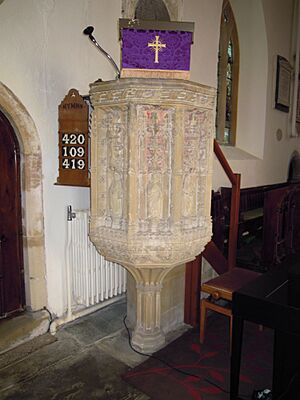
During the 1860s restoration, a stone pulpit was found buried under the church floor. A pulpit is where the priest stands to give sermons. This one is shaped like a wine glass and is thought to be from the 1400s. It has beautiful carvings of Jesus and the Four Evangelists, who wrote the Gospels. It still has some of its original color, but it was repaired a lot in the 1800s.
The baptismal font was made in 1867. It has lovely carvings around its bowl, showing Noah's Ark and the dove finding land. Also carved on the bowl are words from Jesus: "Suffer little children to come unto me, and forbid them not: for of such is the kingdom of God."
The church organ was once in a private home. It was given to the church and installed in 1907. It has a hand-cranked pianola roll, which means it can play music automatically. The organ was rebuilt in 2002. On the south wall, there's a small piece of an old medieval wall painting. It shows two angels and two towers of the Holy City.
Decorations and Art
The reredos is a decorated screen behind the altar. It's made of alabaster and Caen stone. It has the symbols Alpha and Omega carved on it, which mean "the first and the last." The altar table itself is from the time of Queen Elizabeth I.
Above the main door, there's a large painted panel. It shows the Royal Coat of Arms of Queen Anne. This was put there between 1707 and 1714, after England and Scotland joined together to form Great Britain.
The church has many beautiful stained glass windows from the 1800s and 1900s. They show different Bible stories, like Jesus blessing children, the Good Shepherd, and the story of the Good Samaritan.
Bells and Memorials
The bell tower has six bells that can be rung. There are also two older medieval bells that are no longer used and are stored in the bell chamber. Inside the church, you can find memorials and tablets on the walls. These remember people from the past, like Susanna Davie who died in 1694, and George Bragg who died in 1629. There are also five diamond-shaped wooden panels with painted family crests, and a large monument from the 1700s dedicated to the Harding family.


